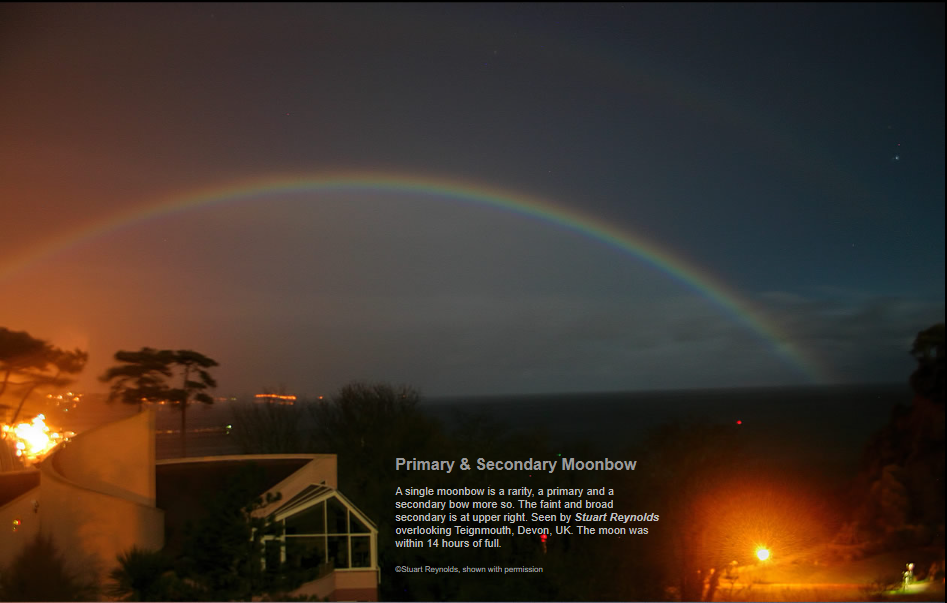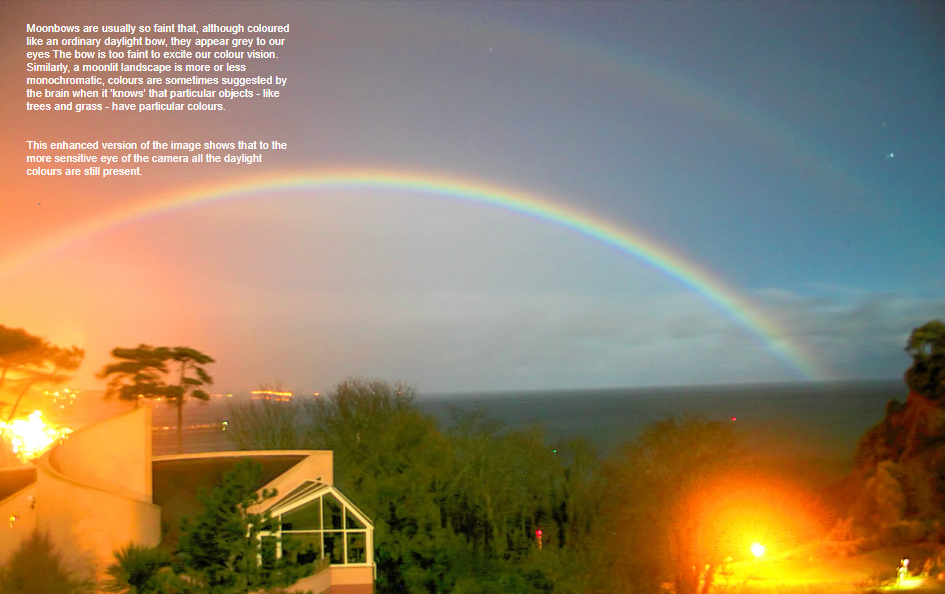Primary & secondary moonbow - OPOD
Primary & Secondary Moonbow: A Rare and Enchanting Atmospheric Phenomenon
Have you ever witnessed a moonbow? These ethereal rainbows that appear under the gentle glow of the moon are a rare and captivating sight. While a single moonbow is already an uncommon occurrence, the presence of both a primary and a secondary bow makes it even more extraordinary. In this article, we will delve into the enchanting world of primary and secondary moonbows, exploring their characteristics, formation, and the awe-inspiring beauty they bring to the night sky.
Moonbows are often so faint that our eyes perceive them as shades of gray rather than the vibrant hues we see in daylight rainbows. The reason behind this lies in the intensity of moonlight. Moonlight is significantly dimmer than sunlight, which means that the amount of light available for refraction and reflection is also much lower. Consequently, moonbows appear less saturated and their colors are subdued.
However, when we capture moonbows with a camera, their true colors are revealed. The enhanced version of the image provided shows that all the familiar colors of a daylight rainbow are still present, even though our eyes cannot perceive them to the same extent. This phenomenon highlights the difference in sensitivity between our eyes and camera sensors, allowing us to appreciate the full spectrum of colors that exist within moonbows.
Moonlit landscapes, too, exhibit a monochromatic appearance to our eyes. The low light levels during moonlit nights limit our ability to perceive colors accurately. However, our brain compensates for this limitation by filling in the missing colors based on our knowledge of the objects in the scene. For instance, we "know" that trees are green and grass is green, so our brain may suggest those colors even if we cannot discern them clearly.
To witness both a primary and a secondary moonbow in a single display is an extraordinary event. The primary moonbow is the brighter and more distinct of the two, forming a gentle arc in the sky. It is created through the same process as a daytime rainbow, with moonlight refracting and reflecting within raindrops. The secondary moonbow, on the other hand, is fainter and broader, appearing at the opposite side of the primary bow. It forms when light undergoes two internal reflections within raindrops, resulting in a secondary arc that is larger and less saturated than the primary one.
The formation of a moonbow requires specific conditions to align perfectly. Firstly, the moon must be nearly full, ideally within 14 hours of its fullest phase. This ensures that there is sufficient moonlight to create a visible bow. Secondly, rain or other sources of water droplets must be present in the atmosphere. The droplets act as prisms, bending and dispersing the moonlight to form the moonbow. Lastly, the moon must be relatively low in the sky, typically no higher than 42 degrees above the horizon. This positioning allows for the optimal angle between the moon, the observer, and the raindrops.
Moonbows are most commonly observed near waterfalls or in areas with high humidity, where the chances of raindrops being present in the air are higher. These ethereal displays often leave spectators in awe of nature's ability to create such beauty in the night sky. The rarity and delicacy of primary and secondary moonbows make them particularly captivating and sought-after by both photographers and astronomy enthusiasts.
In conclusion, primary and secondary moonbows are mesmerizing phenomena that grace our night skies on rare occasions. Their delicate beauty and subtle colors evoke a sense of wonder and enchantment. While our eyes may perceive them as faint or monochromatic, technology allows us to capture their true vibrancy. So, keep your eyes on the night sky, especially during a nearly full moon and in the presence of rain or mist. You may just be fortunate enough to witness the magical dance of a primary and secondary moonbow, a breathtaking spectacle that reminds us of the mysteries and wonders that lie beyond our earthly realm.

Primary & Secondary Moonbow
A single moonbow is a rarity, a primary and a secondary bow more so. The faint and broad secondary is at upper right. Seen by Stuart Reynolds overlooking Teignmouth, Devon, UK. The moon was within 14 hours of full.
©Stuart Reynolds, shown with permission

Moonbows are usually so faint that, although coloured like an ordinary daylight bow, they appear grey to our eyes The bow is too faint to excite our colour vision. Similarly, a moonlit landscape is more or less monochromatic, colours are sometimes suggested by the brain when it 'knows' that particular objects - like trees and grass - have particular colours.
This enhanced version of the image shows that to the more sensitive eye of the camera all the daylight colours are still present.
Note: this article has been automatically converted from the old site and may not appear as intended. You can find the original article here.
Reference Atmospheric Optics
If you use any of the definitions, information, or data presented on Atmospheric Optics, please copy the link or reference below to properly credit us as the reference source. Thank you!
-
<a href="https://atoptics.co.uk/blog/primary-secondary-moonbow-opod/">Primary & secondary moonbow - OPOD</a>
-
"Primary & secondary moonbow - OPOD". Atmospheric Optics. Accessed on December 15, 2024. https://atoptics.co.uk/blog/primary-secondary-moonbow-opod/.
-
"Primary & secondary moonbow - OPOD". Atmospheric Optics, https://atoptics.co.uk/blog/primary-secondary-moonbow-opod/. Accessed 15 December, 2024
-
Primary & secondary moonbow - OPOD. Atmospheric Optics. Retrieved from https://atoptics.co.uk/blog/primary-secondary-moonbow-opod/.